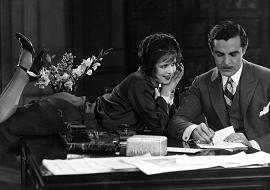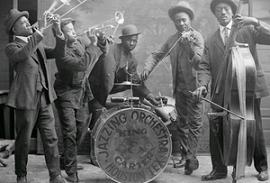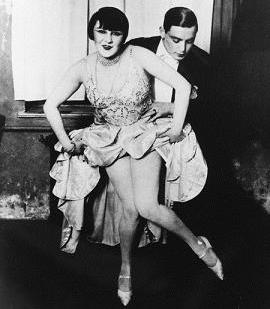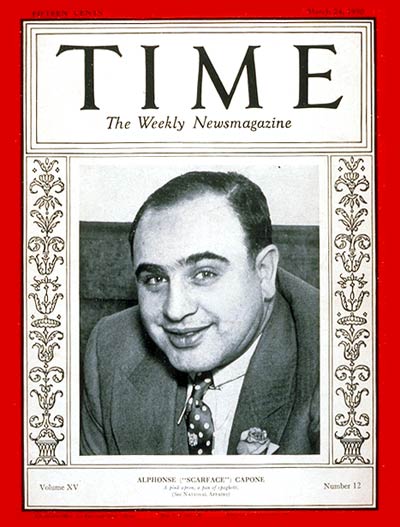|
       
The 'Roaring Twenties'
II Entertainment, Prohibition and Crime
The pace was faster, the buildings were higher, the morals were looser and liqor was cheaper.
F Scott Fitzgerald, Echoes of the Jazz Age (1931).
|
Going Deeper
The links below will help you widen your knowledge:
|
1. Entertainment
-
Films
movie actors such as Charlie
Chaplin, Rudolf Valentino and Mary Pickford became 'stars'.
in 1927, The Jazz Singer,
a movie starring Al Jolson, was the first 'talkie'. -
a well-known early two-colour film was The Toll of the Sea (1922) and two-colour films were common by the end of the 1920s; after 1932, films were produced in three-colour technicolour.
-
Mickey Mouse was created by Walt Disney in 1928 (who released Snow White in colour in 1937).
-
by 1930, 100 million Americans went to the movies every week
-
companies like United Artists and MGM produced hundreds of films a year.
-
films taught people new fashions (e.g. smoking) and new ways to behave many girls wanted to be like
'It' girl, Clara Bow.
-
Jazz
Jazz was first played in New
Orleans by black musicians such as Louis Armstrong and Jelly Roll Morton.
After 1917, racist violence forced many of them to leave New Orleans, so they
went north to play in the night clubs of towns like Chicago and New York.
The invention of radio and the phonograph (record player) made it available in people's homes. The first jazz record was made in 1917 by the Dixieland Jazz Band. They were called 'race records', because they were recorded by black musicians. -
Because it was often played in speakeasies, by black musicians, it was seen as wild and exciting - which soon made it very popular.
-
Jazz music contributed to many of the social developments of the age baggy trousers and short skirts, wild dancing such as the Black Bottom, and a new kind of convention-free poetry called 'jazz poetry' (poets such as TS Eliot and ee cummings). It was part of the Harlem Renaissance, and the growth of black pride (see
here).
-
Dances
The Charleston a fast
dance developed in Black communities was adopted by flappers, who danced
it alone to challenge the 'drys' who wouldn't go out to clubs. (Both Joan
Crawford and Ginger Rodgers began their movie careers by winning Charleston
competitions.)
The 'Black Bottom Stomp' was first recorded by Jelly Roll Morton.
It was named after Black Bottom a Black neighbourhood in Detroit. After 1926 it became the most popular dance. -
The dances scandalised many Americans, who thought they were immoral.
|

Clara Bow the 'It' girl, playing self-confident shop-girl
Betty Lou Spence, who has it and is it, flirting with rich businessman Cyrus
Waltham.
Watch clips from the movie
'It' on YouTube.

The King & Carter Jazzing Orchestra, 1921.

Dancing
The Charleston

|
2. Prohibition
In 1919 - as the result of a long and powerful campaign (see
panel) the 18th Amendment to the Constitution made the manufacture, transport or sale of alcoholic drinks illegal. The Volstead Act, passed at the same time, declared any drink more than 5% proof 'alcoholic'.
ARGUMENT 1: Prohibition was a failure [DAMAGE]
-
Drinking continued: impossible to
enforce (not enough police only 4000 agents, many of whom were sacked for
taking bribes).
-
Available: the liquor trade just 'went underground'. speakeasies (illegal bars), moonshine (illegally-made alcohol), bootlegging (smuggling alcohol to sell). It is sometimes asserted that there were more speakeasies than there had been saloons (not true, but there were 200,000 speakeasies in 1933).
-
Made criminals of ordinary people.
-
Adverse effects: moonshine was poor quality and sometimes killed people. 'Jackass brandy' caused internal bleeding, 'Soda Pop Moon' contained poisonous alcohol.
-
Gangsterism flourished running the illegal trade: It became hugely profitable, and led to a growth of violence, protection rackets
etc. associated with the illegal trade (see 'Organised Crime' below). The general flouting brought the rule of law in general into disrepute as police 'turned a blind eye. Corruption grew.
-
End: in 1933 the 21st Amendment abolished Prohibition (= 'proved' that it failed
- see panel).
ARGUMENT 2: Prohibition was a success [ALE]
-
Amount of alcohol destroyed: in 1929, 50
million litres of illegal alcohol were discovered and destroyed.
-
Legacy: the actual consumption of alcohol fell, not just during prohibition, but for many years after did not reach pre-1914 levels until 1971.
-
Eliot Ness and the Untouchables: became famous as examples of the high standards police SHOULD achieve.
|
BBC Bitesize -
Prohibition
Brilliant Prohibition mindmap
Good Essay arguing the traditional case that Prohibition was a failure.
'Wets' and 'Dries' - extensive resources
Podcast
 - BBC Bitesize on Prohibition and organised crime
- BBC Bitesize on Prohibition and organised crime
YouTube
Great Student video
AQA-suggested Interpretation of Prohition and Crime:
Felix von Luckner, Sea
Devil Conquers America (1928)
Felix Luckner's comments on Prohibition
WHY PROHIBITION? [A CRIME]
Anti-Saloon League
campaigned that drink hurt families because men wasted money on beer,
that it ruined their health and lost them their jobs, and that it led to
domestic violence and neglect.
-
Christian organisation
esp. Women's Christian Temperance Union supported prohibition. (The early 20th century was a time of Christian revival.)
-
Rural America
scandalised by behaviour in the towns supported it.
-
Isolationism
it was said that money spent on drink flew away to Germany
because much of the beer drunk in America was brewed there.
-
Madness, crime, poverty and illness
were seen as caused by alcohol many (including BOTH my grandparents, 'signed the pledge' never to drink.)
-
Easy Street
Charlie Chaplins comic film (1917) showed how drink damaged, and
Christianity nurtured, families' happiness and prosperity.
WHY PROHIBITION FAILED [NCP]
Not enough Enforcement Agents
only 4,000 for the whole of America
-
Corruption and bribes one tenth of Agents sacked for taking bribes
-
Public opposition
most people did NOT support the ban.
|
3. Organised Crime
Organised crime stepped in to take over from the breweries and spirits manufacturers:
They ran the speakeasies,
and bootlegging.
They also ran
protection rackets, prostitution and drug-running.
-
They bribed trade union leaders, police, lawyers, judges and even Senators.
-
The most famous gangster was Al Capone, who earned $100,000 a year from beer sales alone, ran a private army of more than 700 mobsters, and is thought to have murdered more than 200 opponents.
-
They fought with each other for control of their 'territory' the most famous incident was
the St Valentine's Day Massacre in 1929, when 'torpedoes' from Capone's gang shot dead 7 members of Bugs Moran's gang.
Consider:
1. Draw a mindmap to chart all the connections between
Entertainment, Prohibition and Crime.
2. Use the information and links on this page to write an essay: "What impact did prohibition and organised crime have on American society?".
Was Prohibition a failure?
- AQA Exam-style
Questions
4. Describe two problems faced by Americans during Prohibition.
5. In what ways were the lives of Americans in the
1920s affected by:
cultural changes
Prohibition?
6. Which of the following had more impact on
America in the 1920s:
economic growth
social and
cultural changes?
- OCR-style Questions
5. Describe one
way the US goveernment tried to implement Prohibition.
6. Explain why the US government passed the 18th Amendment in
1919.
8. More success than failure. How far do you agree with this view
of Prohibition?
-
iGCSE-style Questions
(a) Describe TWO features of the leisure industry in America in the 1920s.
Describe TWO features of gangsterism in America in the 1920s.
(b-c) Click to see the questions 
|
Source A

In 1930, Al Capone made the front page of Time magazine.
Source B
Prohibition is a business. All I do is supply a public demand. I do it in the best and least harmful way I can.
Al Capone.
|
|
|
Spotted an error on this page? Broken link? Anything missing?
Let me know.
|
    
|
